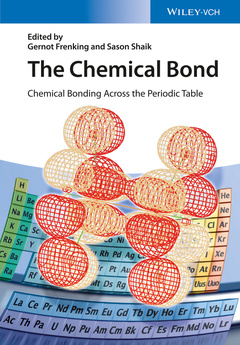Description
The Chemical Bond
Chemical Bonding Across the Periodic Table
Coordinators: Frenking Gernot, Shaik Sason
Language: English
Subject for The Chemical Bond:
Keywords
Molecules and Matter with Chemical Bonding; Gernot Frenking; Sason Shaik; Chemical bonding of main-group elements; Multiple bonding of heavy main-group elements; Hypervalent compounds: the Lewis picture; Chemical bonding in transition metal complexes; No-Pair bonding among monovalent atoms; Chemical bonding in cluster compounds; Inorganic aromatics; Dispersion interaction and chemical bonding
566 p. · 17.5x25 cm · Hardback
Description
/li>Contents
/li>Biography
/li>
CHEMICAL BONDING OF MAIN-GROUP ELEMENTS
Introduction and Definitions
The Lack of Radial Nodes of the 2p Shell Accounts for Most of the Peculiarities of the Chemistry of the 2p-Elements
The Role of the Outer d-Orbitals in Bonding
Secondary Periodicities: Incomplete-Screening and Relativistic Effects
"Honorary d-Elements": the Peculiarities of Structure and Bonding of the Heavy Group 2 Elements
Concluding Remarks
MULTIPLE BONDING OF HEAVY MAIN-GROUP ATOMS
Introduction
Bonding Analysis of Diatomic Molecules E2 (E = N -
Bi)
Comparative Bonding Analysis of N2 and P2 with N4 and P4
Bonding Analysis of the Tetrylynes HEEH (E = C -
Pb)
Explaining the Different Structures of the Tetrylynes HEEH (E = C -
Pb)
Energy Decomposition Analysis of the Tetrylynes HEEH (E = C -
Pb)
Conclusion
THE ROLE OF RECOUPLED PAIR BONDING IN HYPERVALENT MOLECULES
Introduction
Multireference Wavefunction Treatment of Bonding
Low-Lying States of SF and OF
Low-Lying States of SF2 and OF2 (and Beyond)
Comparison to Other Models
Concluding Remarks
DONOR-ACCEPTOR COMPLEXES OF MAIN-GROUP ELEMENTS
Introduction
Single-Center Complexes EL2
Two-Center Complexes E2L2
Summary and Conclusion
ELECTRON-COUNTING RULES IN CLUSTER BONDING -
POLYHEDRAL BORANES, ELEMENTAL BORON, AND BORON-RICH SOLIDS
Introduction
Wade's Rule
Localized Bonding Schemes for Bonding in Polyhedral Boranes
4n + 2 Interstitial Electron Rule and Ring-Cap Orbital Overlap Compatibility
Capping Principle
Electronic Requirement of Condensed Polyhedral Boranes - mno Rule
Factors Affecting the Stability of Condensed Polyhedral Clusters
Hypoelectronic Metallaboranes
Electronic Structure of Elemental Boron and Boron-Rich Metal Borides -
Application of Electron-Counting Rules
Conclusion
BOUND TRIPLET PAIRS IN THE HIGHEST SPIN STATES OF MONOVALENT METAL CLUSTERS
Introduction
Can Triplet Pairs Be Bonded?
Origins of NPFM Bonding in n+1Lin Clusters
Generalization of NPFM Bonding in n+1Lin Clusters
NPFM Bonding in Coinage Metal Clusters
Valence Bond Modeling of the Bonding in NPFM Clusters of the Coinage Metals
NPFM Bonding: Resonating Bound Triplet Pairs
Concluding Remarks: Bound Triplet Pairs
Appendix
CHEMICAL BONDING IN TRANSITION METAL COMPOUNDS
Introduction
Valence Orbitals and Hybridization in Electron-Sharing Bonds of Transition Metals
Carbonyl Complexes TM(CO)6q (TMq = Hf2-, Ta-, W, Re+, Os2+, Ir3+)
Phosphane Complexes (CO)5TM-PR3 and N-Heterocyclic Carbene Complexes (CO)5TM-NHC (TM = Cr, Mo, W)
Ethylene and Acetylene Complexes (CO)5TM-C2Hn and Cl4TM-C2Hn (TM = Cr, Mo, W)
Group-13 Diyl Complexes (CO)4Fe-ER ( E = B -
Tl;
R = Ph, Cp)
Ferrocene Fe(n5-Cp)2 and Bis(benzene)chromium Cr(n6-Bz)2
Cluster, Complex, or Electron-Sharing Compound? Chemical Bonding in Mo(Eh)12 and Pd(EH)8 (E = Zn, Cd, Hg)
Metal-Metal Multiple Bonding
Summary
CHEMICAL BONDING IN OPEN-SHELL TRANSITION-METAL COMPLEXES
Introduction
Theoretical Foundations
Qualitative Interpretation
Spin Density Distributions -
A Case Study
Summary
MODELING METAL-METAL MULTIPLE BONDS WITH MULTIREFERENCE QUANTUM CHEMICAL METHODS
Introduction
Multireferance Methods and Effective Bond Orders
The Multiple Bond in Re2Cl8 2-
Homonuclear Diatomic Molecules: Cr2, Mo2, and W2
Cr2, Mo2, and W2 Containing Complexes
Fe2 Complexes
Concluding Remarks
THE QUANTUM CHEMISTRY OF TRANSITION METAL SURFACE BONDING AND REACTIVITY
Introduction
The Elementary Quantum-Chemical Model of the Surface Chemical Bond
Quantum Chemistry of the Surface Chemical Bond
Metal Particle Composition and Size Dependence
Lateral Interactions;
Reconstruction
Adsorbate Bond Activation and Formation
Transition State Analysis: A Summary
CHEMICAL BONDING OF LANTHANIDES AND ACTINIDES
Introduction
Technical Issues
The Energy Decomposition Approach to the Bonding in f Block Compounds
f Block Applications of the Electron Localization Function
Does Covalency Increase or Decrease across the Actinide Series?
Multi-configurational Descriptions of Bonding in f Element Complexes
Concluding Remarks
DIRECT ESTIMATE OF CONJUGATION, HYPERCONJUGATION, AND AROMATICITY WITH THE ENERGY DECOMPOSITION ANALYSIS METHOD
Introduction
The EDA Method
Conjugation
Hyperconjugation
Aromaticity
Concluding Remarks
MAGNETIC PROPERTIES OF AROMATIC COMPOUNDS AND AROMATIC TRANSITION STATES
Introduction
A Short Historical Review of Aromaticity
Magnetic Properties of Molecules
Examples
Concluding Remarks
CHEMICAL BONDING IN INORGANIC AROMATIC COMPOUNDS
Introduction
How to Recognize Aromaticity and Antiaromaticity?
"Conventional" Aromatic/Antiaromatic Inorganic Molecules
"Unconventional" Aromatic/Antiaromatic Inorganic Molecules
Summary and Perspectives
CHEMICAL BONDING IN SOLIDS
Introduction
Electronic Structure of Solids: Basic Notions
Bonding in Solids: Some Illustrative Cases
Concluding Remarks
DISPERSION INTERACTION AND CHEMICAL BONDING
Introduction
A Short Survey of the Theory of the London Dispersion Energy
Theoretical Methods to Compute the Dispersion Energy
Selected Examples
Conclusion
Computational Details
HYDROGEN BONDING
Introduction
Fundamental Properties of Hydrogen Bonds
Hydrogen Bonds with Varying Strengths
Hydrogen Bonds in Biological Molecules
Theoretical Description of Hydrogen Bonding
Summary
DIRECTIONAL ELECTROSTATIC BONDING
Introduction
Anisotropic Molecular Electrostatic Potential Distribution Around Atoms
Electrostatic Anisotropy, Donor-Acceptor Interactions and Polarization
Purely Electrostatic Models
Difference-Density Techniques
Directional Noncovalent Interactions
Conclusions
Index
Sason Shaik is a graduate of the University of Washington (USA), where he also obtained his PhD. After a postdoctoral year at Cornell University, he became Lecturer at Ben-Gurion University of the Negev (Israel), where he became Professor in 1988. In 1992 he moved to The Hebrew University where he is Professor and the Director of the Lise Meitner-Minerva Center for Computational Quantum Chemistry.




